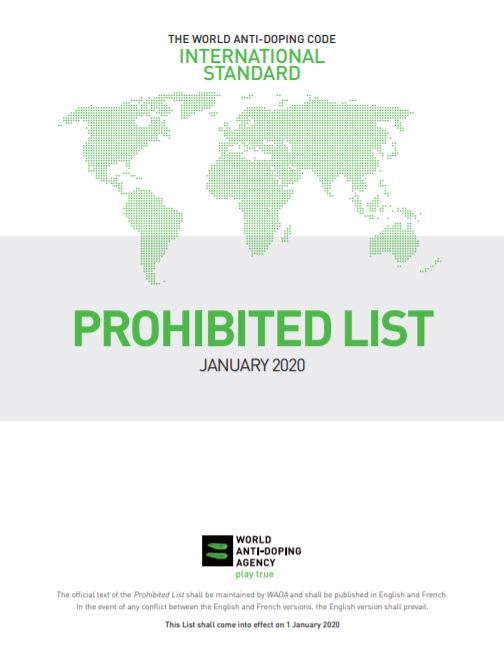 DISCLAIMER: This content is NOT being updated and is only current as of the publication date.
DISCLAIMER: This content is NOT being updated and is only current as of the publication date.
As many athletes know, the World Anti-Doping Agency (WADA) Prohibited List is updated every year and goes into effect on January 1. The Prohibited List is reviewed and updated annually, but significant changes may not always occur, which is the case for the 2020 Prohibited List.
For 2020, WADA only made clarifications to the List to help athletes and their support teams better identify and understand prohibited substances and methods. A couple of those clarifications are highlighted below, along with some of the most important anti-doping reminders for 2020.
1. Key Prohibited List Clarifications in 2020
- Instead of identifying anabolic androgenic steroids (AAS) as exogenous (external origin) or endogenous (internal origin), all AAS have been combined into one class under S1 Anabolic Agents of the Prohibited List. WADA made this clarification to better recognize that all anabolic agents are prohibited when administered exogenously. This clarification also makes S1 more consistent with other categories of the List that don’t distinguish endogenous from exogenous. Separate technical documents provide guidance on determining a substances’ origin as endogenous or exogenous.
- Under the S8 Cannabinoids category, WADA clarified that:
- All natural (cannabis, marijuana, and hashish) and synthetic cannabinoids are prohibited in-competition.
- Natural and synthetic THC are prohibited in-competition.
- All synthetic cannabinoids that mimic the effects of THC are prohibited in-competition.
- While cannabidiol (CBD) is not prohibited, athletes should be extremely cautious because it’s nearly impossible to obtain a pure CBD extract or oil from the cannabis plant. Anyone who buys a CBD oil, extract, or other CBD product should assume that it is a mixture of CBD and other prohibited cannabinoids.
A full list of modifications to the 2020 WADA Prohibited List is available here.
2. Important Anti-Doping Reminders
There are no major changes to the 2020 Prohibited List, but below are some key reminders about substances and methods that athletes frequently ask about.
- IVs: All IV infusions and/or injections of any substance, prohibited or permitted, in excess of 100 mL per 12-hour period are prohibited at all times, except for those legitimately received in the course of hospital treatment, surgical procedures, or clinical diagnostic investigations. In all other circumstances, an approved Therapeutic Use Exemption (TUE) is required in advance of an IV infusion above the limit and/or involving a prohibited substance.
- ADD/ADHD Medications: Athletes with ADD/ADHD can continue using necessary prohibited stimulant medications while competing in sanctioned sports as long as they receive a TUE in advance, which requires them to demonstrate that they can satisfy strict criteria for TUE approval.
- Inhalers: Athletes are often prescribed medication, such as beta-2 agonists and glucocorticoids, delivered by inhalers, so it’s important to understand what inhalers and doses are permitted, and when a TUE is needed.
- Clomiphene and Fertility: Clomiphene is an FDA-approved fertility treatment for females, but it’s also prohibited at all times in sport. Female athletes treating infertility with clomiphene or other prohibited treatments should apply for a TUE in advance of use.
- Spironolactone: Spironolactone can be prescribed off-label to treat acne in adult women, but it is prohibited at all times as a diuretic and masking agent. A TUE in advance of use is required.
- Illegal Supplement Ingredients: Unfortunately, there is an ever-growing list of ingredients that are frequent contaminants in dietary supplements, including those listed below. Many of these substances are not FDA-approved for human use or consumption anywhere in the world.
- Acetazolamide: It may be easy to assume that a diuretic to treat a common illness, such as altitude sickness, is safe to use if you’re an athlete. Especially if it’s prescribed by a physician. However, diuretics like acetazolamide are prohibited in sport.
3. Global DRO
While USADA has a team available to help answer your specific questions (contact info below), we also urge you to use GlobalDRO.com to search the prohibited status of your medications and ingredients.
4. Reducing Risk from Supplements
Dietary supplements are regulated in a post-market fashion, which means that no regulatory body approves the accuracy of the label or safety of the contents before they are sold to consumers. As such, no dietary supplement can be guaranteed to be 100 percent risk-free. If athletes choose to use supplements despite the known risks, USADA currently recommends using NSF Certified for Sport® supplements as the best way to reduce that risk.
5. Strict Liability
As always, athletes subject to testing are strictly liable for any substance found in their blood or urine. Urine and blood sample(s) can be tested for more than 500 prohibited substances and metabolites. Samples are also routinely stored for reanalysis for up to 10 years and specialized analysis is conducted for additional substances based on the Athlete Biological Passport.
More questions?
For questions about specific products, substances, and methods, contact USADA’s Drug Reference Line at drugreference@usada.org or call (719) 785-2000, option 2.
Read more Spirit of Sport blog posts



